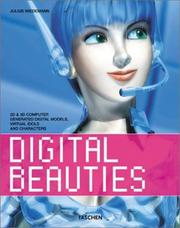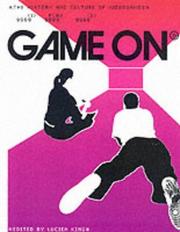| Listing 1 - 10 of 39 | << page >> |
Sort by
|
Book
ISBN: 9789012585385 Year: 2013 Publisher: Den Haag : Academic Service,
Abstract | Keywords | Export | Availability | Bookmark
 Loading...
Loading...Choose an application
- Reference Manager
- EndNote
- RefWorks (Direct export to RefWorks)
PXL-IT 2016 --- programmeren --- software --- gamedesign --- grafische programma's
Periodical
Abstract | Keywords | Export | Availability | Bookmark
 Loading...
Loading...Choose an application
- Reference Manager
- EndNote
- RefWorks (Direct export to RefWorks)
The only magazine in the UK totally dedicated to all aspects of retro gaming, containing exclusive interviews with classic developers, behind the scenes access to the biggest games of all time, and fascinating new facts about all of your favourite games.
527 --- gamedesign --- tijdschriften (serials) --- games --- informatica - specifieke toepassingen --- Periodicals
Book
ISBN: 9780262027922 9780262325950 0262325950 9780262325967 0262325969 0262027925 Year: 2014 Publisher: Cambridge, Massachusetts [Piscataqay, New Jersey] MIT Press IEEE Xplore
Abstract | Keywords | Export | Availability | Bookmark
 Loading...
Loading...Choose an application
- Reference Manager
- EndNote
- RefWorks (Direct export to RefWorks)
"What do we think about when we think about play? A pastime? Games? Childish activities? The opposite of work? Think again: If we are happy and well rested, we may approach even our daily tasks in a playful way, taking the attitude of play without the activity of play. So what, then, is play? In Play Matters, Miguel Sicart argues that to play is to be in the world; playing is a form of understanding what surrounds us and a way of engaging with others. Play goes beyond games; it is a mode of being human. We play games, but we also play with toys, on playgrounds, with technologies and design. Sicart proposes a theory of play that doesn't derive from a particular object or activity but is a portable tool for being--not tied to objects but brought by people to the complex interactions that form their daily lives. It is not separated from reality; it is part of it. It is pleasurable, but not necessarily fun. Play can be dangerous, addictive, and destructive. long the way, Sicart considers playfulness, the capacity to use play outside the context of play; toys, the materialization of play--instruments but also play pals; playgrounds, play spaces that enable all kinds of play; beauty, the aesthetics of play through action; political play -- from Maradona's goal against England in the 1986 World Cup to the hactivist activities of Anonymous; the political, aesthetic, and moral activity of game design; and why play and computers get along so well."
Jeu --- Play --- Psychological aspects --- 527 --- gamedesign. --- Psychological aspects. --- Specifieke toepassingen van informatica. --- Jeu. --- gamedesign --- Specifieke toepassingen van informatica --- informatica - specifieke toepassingen
Book
ISBN: 9780997316025 0997316020 9780997316001 0997316004 Year: 2017 Publisher: Las Vegas Code Energy LLC
Abstract | Keywords | Export | Availability | Bookmark
 Loading...
Loading...Choose an application
- Reference Manager
- EndNote
- RefWorks (Direct export to RefWorks)
A walkthrough of computer science concepts that you must know to program computers effectively. After a simple introduction to discrete math, it presents common algorithms and data structures. It also outlines the principles that make computers and programming languages work.
Computer algorithms --- Computer science --- 527 --- gamedesign --- programmeren --- Informatics --- Science --- Algorithms --- informatica - specifieke toepassingen --- Computer algorithms. --- Computer science. --- gamedesign. --- programmeren. --- Informatica - specifieke toepassingen. --- Informatica --- ICT
Book
ISBN: 9780134392233 013439223X 0134392078 9780134392073 Year: 2016 Publisher: Boston Addison-Wesley
Abstract | Keywords | Export | Availability | Bookmark
 Loading...
Loading...Choose an application
- Reference Manager
- EndNote
- RefWorks (Direct export to RefWorks)
The play-focused, step-by-step guide to creating great game designs This book offers a play-focused, process-oriented approach for designing games people will love to play. Drawing on a combined 35 years of design and teaching experience, Colleen Macklin and John Sharp link the concepts and elements of play to the practical tasks of game design. Using full-color examples, they reveal how real game designers think and work, and illuminate the amazing expressive potential of great game design. Focusing on practical details, this book guides you from idea to prototype to playtest and fully realized design. You'll walk through conceiving and creating a game's inner workings, including its core actions, themes, and especially its play experience. Step by step, you'll assemble every component of your videogame, creating practically every kind of play: from cooperative to competitive, from chance-based to role-playing, and everything in between. Macklin and Sharp believe that games are for everyone, and game design is an exciting art form with a nearly unlimited array of styles, forms, and messages. Cutting across traditional platform and genre boundaries, they help you find inspiration wherever it exists. Games, Design and Play is for all game design students, and for beginning-to-intermediate-level game professionals, especially independent game designers. Bridging the gaps between imagination and production, it will help you craft outstanding designs for incredible play experiences! Coverage includes: Understanding core elements of play design: actions, goals, rules, objects, playspace, and players - Mastering tools such as constraint, interaction, goals, challenges, strategy, chance, decision, storytelling, and context. - Comparing types of play and player experiences. - Considering the demands videogames make on players. - Establishing a game's design values. - Creating design documents, schematics, and tracking spreadsheets. - Collaborating in teams on a shared design vision. - Brainstorming and conceptualizing designs. - Using prototypes to realize and playtest designs. - Improving designs by making the most of playtesting feedback. - Knowing when a design is ready for production. - Learning the rules so you can break them!
Video games --- Computer games --- 527 --- gamedesign --- Design --- informatica - specifieke toepassingen --- Design.
Book
ISBN: 9780262029070 0262029073 Year: 2015 Publisher: Cambridge, Massachusetts : The MIT Press,
Abstract | Keywords | Export | Availability | Bookmark
 Loading...
Loading...Choose an application
- Reference Manager
- EndNote
- RefWorks (Direct export to RefWorks)
"Games and art have intersected at least since the early twentieth century, as can be seen in the Surrealists' use of Exquisite Corpse and other games, Duchamp's obsession with Chess, and Fluxus event scores and boxes--to name just a few examples. Over the past fifteen years, the synthesis of art and games has clouded for both artists and gamemakers. Contemporary art has drawn on the tool set of videogames, but has not considered them a cultural form with its own conceptual, formal, and experiential affordances. For their part, game developers and players focus on the innate properties of games and the experiences they provide, giving little attention to what it means to create and evaluate fine art. In Works of Game, John Sharp bridges this gap, offering a formal aesthetics of games that encompasses the commonalities and the differences between games and art. Sharp describes three communities of practice and offers case studies for each. 'Game Art,' which includes such artists as Julian Oliver, Cory Arcangel, and JODI (Joan Heemskerk and Dirk Paesmans) treats videogames as a form of popular culture from which can be borrowed subject matter, tools, and processes. 'Artgames,' created by gamemakers including Jason Rohrer, Brenda Romero, and Jonathan Blow, explore territory usually occupied by poetry, painting, literature, or film. Finally, 'Artists' Games'--with artists including Blast Theory, Mary Flanagan, and the collaboration of Nathalie Pozzi and Eric Zimmerman--represents a more synthetic conception of games as an artistic medium. The work of these gamemakers, Sharp suggests, shows that it is possible to create game-based artworks that satisfy the aesthetic and critical values of both the contemporary art and game communities."--Publisher description.
Video games --- Aesthetics --- Design --- Aesthetics. --- Design. --- 527 --- games --- gamedesign --- informatica - specifieke toepassingen --- Jeu vidéo --- Video games - Design

ISBN: 3822816280 9783822816288 Year: 2001 Publisher: Köln Taschen
Abstract | Keywords | Export | Availability | Bookmark
 Loading...
Loading...Choose an application
- Reference Manager
- EndNote
- RefWorks (Direct export to RefWorks)
Digital Beauties is not a technical "how to" book. It is an inspirational guide to the digital creation of feminine subjects. It has very rich information on how artists from all around the world created their masterpieces. This information is not as technical as a software command; rather, it is a signpost for creative exploration.
Computer drawing. --- Computer drawing --- 684.94 --- figuurtekenen --- gamedesign --- games --- Computer graphics --- Drawing --- Image processing --- het boek, boekillustratie --- Digital techniques

ISBN: 185669304X Year: 2002 Publisher: London Laurence King
Abstract | Keywords | Export | Availability | Bookmark
 Loading...
Loading...Choose an application
- Reference Manager
- EndNote
- RefWorks (Direct export to RefWorks)
#VCV monografie 2003 --- computerspelen --- video games --- gamedesign --- 527.9 --- informatica - overige specifieke toepassing van informatica --- Video games --- Television games --- Videogames --- Electronic games --- History --- Computer games --- Internet games --- Games
Book
ISBN: 9780816676460 9780816676477 0816676461 081667647X Year: 2011 Volume: 38 Publisher: Minneapolis: University of Minnesota press,
Abstract | Keywords | Export | Availability | Bookmark
 Loading...
Loading...Choose an application
- Reference Manager
- EndNote
- RefWorks (Direct export to RefWorks)
In recent years, computer games have moved from the margins of popular culture to its center. Reviews of new games and profiles of game designers now regularly appear in the New York Times and the New Yorker, and sales figures for games are reported alongside those of books, music, and movies. They are increasingly used for purposes other than entertainment, yet debates about videogames still fork along one of two paths: accusations of debasement through violence and isolation or defensive paeans to their potential as serious cultural works. In How to Do Things with Videogames, Ian Bogost contends that such generalizations obscure the limitless possibilities offered by the medium’s ability to create complex simulated realities. Bogost, a leading scholar of videogames and an award-winning game designer, explores the many ways computer games are used today: documenting important historical and cultural events; educating both children and adults; promoting commercial products; and serving as platforms for art, pornography, exercise, relaxation, pranks, and politics. Examining these applications in a series of short, inviting, and provocative essays, he argues that together they make the medium broader, richer, and more relevant to a wider audience. Bogost concludes that as videogames become ever more enmeshed with contemporary life, the idea of gamers as social identities will become obsolete, giving rise to gaming by the masses. But until games are understood to have valid applications across the cultural spectrum, their true potential will remain unrealized. How to Do Things with Videogames offers a fresh starting point to more fully consider games’ progress today and promise for the future.
Video games --- Social aspects --- 527 --- Games --- gamedesign --- simulaties --- video games --- informatica - specifieke toepassingen --- Jeu vidéo --- Jeu --- Art vidéo --- Informatique appliquée --- Informatique graphique --- Video games - Social aspects
Book
ISBN: 9780990582908 0990582906 Year: 2014 Publisher: Lexington : Genever Benning,
Abstract | Keywords | Export | Availability | Bookmark
 Loading...
Loading...Choose an application
- Reference Manager
- EndNote
- RefWorks (Direct export to RefWorks)
Design patterns revisited -- Sequencing patterns -- Behavioral patterns -- Decoupling patterns -- Optimization patterns.
Computer games --- Spelprogrammering. --- Programming. --- 527 --- Games --- gamedesign --- programmeren --- Programming --- informatica - specifieke toepassingen --- Computer game programming --- Game programming (Computer games) --- Computer programming --- games --- Computer. Automation --- Computer games. --- Programmering.
| Listing 1 - 10 of 39 | << page >> |
Sort by
|

 Search
Search Feedback
Feedback About UniCat
About UniCat  Help
Help News
News